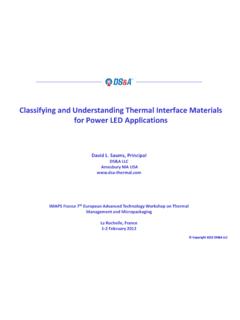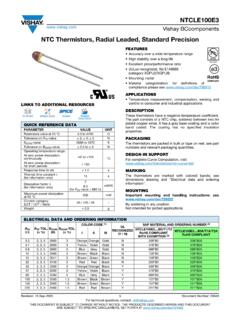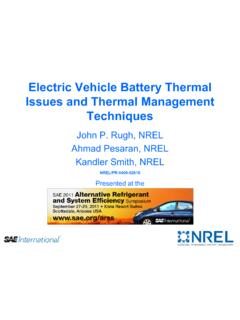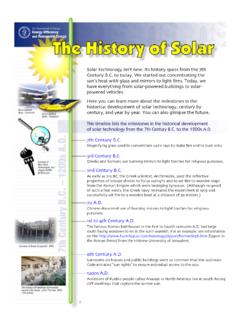Transcription of Analysis of innovation trends in packaging for power modules
1 2012 Analysis of innovation trends in packaging for power modules 7th European Advanced Technology Workshop on Micropackaging and thermal Management February 1st & 2nd IMAPS 2012 Jean-Marc YANNOU, Alexandre Avron, 2012 2 Content Introduction Standard module package cross section drawing Key innovation areas Die interconnection Die attach Substrates (DBC, baseplate) and encapsulation Focus on EV/HEV packaging trend in EV/HEV Case studies: GM, Denso, Conclusions 2012 3 Introduction Standard module package cross section drawing Heatsink thermal grease Substrate SBD IGBT Baseplate DBC Busbar connection Solder Copper metallization Plastic case Common failure in a power module is caused by thermal cycling. Mismatching CTEs (coefficient of thermal expansion) incur adhesion issues, cracks. Some filling gels cannot handle high temperatures Die attach Interconnection Gel filling Substrates attach In red: Common failure locations 2012 4 Introduction Key innovation areas in packaging , with examples Die interconnection DBC + baseplate Die attach Infineon.
2 XT Lexus/toyota modules : LS 600h Prius 2010 Semikron Ag sintering Semikron Skin GE power overlay Viper module Improvements in packaging can be made along 3 different axis: Die interconnection, which is searching for innovative wire bonding or no-wires connection for better lifetime and reliability Die attach, which uses new materials for better lifetime DBC+baseplate, which uses new materials and suppress layers for improved cooling and smaller size All applicable to Si and SiC Includes cooling & substrate attach Danfoss Shower power 2012 5 Die interconnection 2012 6 Die interconnection Available solutions Targets for improvements in interconnection Electrical conductivity thermal conductivity Lifetime ( thermal cycles impact) Al wire bonding Al ribbon bonding Copper wire bonding Semikron Skin Electrical conductivity Taken as reference same 40% better Same (current density is improved) thermal conductivity same 2x better Almost the same Improved (larger pads)
3 Improved thermal performance 70x better (Ag sintering) Lifetime Status In production, still expensive Already in mass volume prod for general semiconductor packaging Close to mass production TODAY Al wirebonding is a fast, cheap and easy process Equipment is widely available It is a historical method since the beginning Wire count and thickness is limited Limited reliability : detaching wires 2012 7 Die interconnection Case study - Infineon .XT Infineon introduced mass production of copper wirebonding power modules Copper Aluminum Electrical resistivity 1,7 .cm 2,7 .cm thermal conductivity 400 220 Source: Infineon Copper wire bonding is the next standard. Biggest are working towards this technology. Equipement is ready as copper wire bonders are widely used for low power and signal It is not expensive and easy to produce in mass compared to gold wires or flip-chip Remaining issue is die metallization Most important players are already working towards this standard 2012 8 Die interconnection Case study Semikron SkiN technology Semikron has revealed in 2011, its innovative interconnection technology using flexible PCB Made of Ag/Cu/polyimide layers and Ag sintered to the chips Flexible foil is replacing wires power cycling performance estimated to be 70 times better power Chip Source.
4 Semikron 2012 9 Die interconnection Case study Fraunhofer Ag sintered bonding Fraunhofer developed and tested Ag sintered ribbon bonding and Ag sintered dies They presented and tested the reliability Metallization must be specific, which is an issue for production This technology has an interest for long lifetime (Wind, rail traction and energy production, some industrial motor drives) 2012 10 Die interconnection Case study Fraunhofer Ag sintered bonding Sintering at low pressure allows: Double sided sintering No bond wires It implies the use of Ag nano-powder There are three parameters when Ag sintering: Time Temperature Pressure Each of these parameter have a linked influence on the results, , we can reduce the time or the pressure, if we increase the temperature proportionally. Reverse way is possible Ribbon bonding solution from Fraunhofer Silver sintering characteristics regarding the type of paste 2012 11 Die attach 2012 12 Die attach Available solutions Targets for improvements of die attach thermal cycling capability Temperature of operation Manufacturability (impacting cost) TODAY Soldering is a fast, cheap and easy process They use a paste or a gel for soldering Historically, it is an alloy of Tin (Sn) and Lead (Pb) But Pb is to be abandoned due to RoHS.
5 Pb-free solution is Sn/Ag (Tin/Silver) soldering Soldering is not suitable for high temperature or multiple steps manufacturing T max is 180 C T melting is 220 C Sn soldering Eutectic soldering Cu/Sn Ag sintering -powder Ag sintering Nano-powder thermal cycling Taken as reference 7x to 10x better 7x to 10x better Minimum 7x to 10x better Up to 400 C Up to 400 C Up to 400 C Temperature Manufacturability In mass production In mass production Difficult to produce (pressure+temperature) At R&D stage Nano-particules regulation issues Will be easier to manufacture 2012 13 Transient Liquid Phase Bonding (TLPB) Eutectic soldering They stack layers of Tin (Sn) and Copper (Cu), and the first melts and diffuse through the other. Result is an alloy of Cu/Sn with progressive percentage. This method is also called Eutectic soldering T m(Cu/Sn) > 400 C Die attach Case study - Infineon.
6 XT & Semikron skinter Used by Infineon in its .XT modules in 2010 Sintering process is now in mass production for Semikron, manufacturing process is as following: An Ag (Silver) powder is compressed at high temperature Compression: 30 MPa to 40 MPa at 250 C 60sec. to 120sec. duration Used by Semikron since 2008 Ag silver paste in provided by companies like 30 MPa 30 MPa 250 C Die Ag powder DBC Ag sintering process: Pressure applied at 250 C 2012 14 Die attach Silver sintering Nano particles sintering Same principle as Ag micro particles sintering Using nano size particles allows a better result with a simpler process : Temperature is much lower down to 20 C Pressure and time are also reduced faster thus cheaper process This technology is still at R&D development Issues from the migration of Ag particles at high temperature still need to be overcome Time-to-market.
7 2012 ( Nano-paste is already available) Silver sintering characteristics regarding the type of paste 2012 15 DBC, Baseplate and encapsulation 2012 16 DBC+Baseplate Available solutions Targets for improvements in DBC+Baseplate assembly Cooling capabilities thermal resistance thermal path Reliability (CTE matching with die) Size and volume reduction Al2O3 Si3N4 AlN AlSiC thermal conductivity Taken as reference same Approx. 7x better Better (depending on alloy ratio) CTE matching Close to Si CTE Closest to Si CTE depending on alloy ratio TODAY DBC is the standard Al203 or Si3N4: The DBC and baseplate materials depend on required performance and cost, in each application Main issue is to match the CTE of the different layers, keeping the highest thermal conductivity We are now looking for improved lifetime and temperature performance Integrated cooling solutions will probably be the next step (baseplates are abandoned with DBC in direct contact with cooling system) AlN benefits from fast increasing volumes of high power LEDs : cost decreasing DBC ceramic materials 2012 17 DBC+Baseplate Material choice is key Materials properties is key for packaging .
8 It is all about a trade-off between: CTE: coefficient of thermal expansion can mismatch between layers thermal conductivity: It improves cooling efficiency Cost But suppressing layers is equal to suppressing issue sources Baseplate materials DBC/DBA materials Soldering materials/process LEGEND: Semiconductor Better thermal conductivity 2012 18 Encapsulations Gel filling Parylene HT vs. Gel solution Coating solution Parylene HT Air fills the empty parts of the module Achieve 400 C Only one company propose it : Specialty Coating Systems Parts must be sent to the company to be coated highly protected process Gel Manufacturer Dielectric strength (kV/mm) CTE (ppm) Max temperature Elastosil RT 745S Wacker 23 N/A ? Nusil R2188 Nusil silicone N/A 240 C Sylgard 567 Dow corning 21 300 200 C Silicone gel Silicone gel max temperature is 200 C There are not many solutions to overcome the issue for now For very high temperature Today s solution 2012 19 FOCUS ON EV/HEV 2012 20 Focus on EV/HEV power module packaging trend in EV/HEV Introduction mm Denso 2004/Honda 2006 Standard packaging Wirebonding Baseplate one side cooling Toyota 2010 Standard packaging Ribbon bonding Direct substrate cooling Today s standard (2011)
9 Honda 2010 Epoxy packaging Cu lead bonding Direct substrate cooling Delphi 2010 Single IGBT/diode packaging Flip-chip soldering Direct substrate cooling Denso 2008 Single IGBT/diode packaging Flip-chip soldering Double side cooling Too expensive Improved cooling Higher integration Industrial standard EV/HEV is one of the biggest market for power electronics in 2020, according to all forecasts The main challenges will include manufacturability, reliability and lifetime, but also integration and weight Module packaging is already a great challenge in EV/HEV: The market is potentially large enough to involve large development efforts The level of integration will lead to custom solutions and all integrated inverters Footprint, size, weight and cost and all are strong technical drivers 2012 21 EV/HEV inverter market forecasts Munits 40% compound annual growth rate aver the 2010-2016 period!
10 2012 22 Focus on EV/HEV power module packaging trend in EV/HEV Introduction mm Denso 2004/Honda 2006 Standard packaging Wirebonding Baseplate one side cooling Toyota 2010 Standard packaging Ribbon bonding Direct substrate cooling Today s standard (2011) Honda 2010 Epoxy packaging Cu lead bonding Direct substrate cooling Delphi 2010 Single IGBT/diode packaging Flip-chip soldering Direct substrate cooling Denso 2008 Single IGBT/diode packaging Flip-chip soldering Double side cooling Too expensive Improved cooling Higher integration Industrial standard 2012 23 Case study Delphi Viper module project Single IGBT/diode packaging Flip-chip soldering Direct substrate cooling Viper power module is at pre-production stage Wirebondless package Double sided cooling 30% lower thermal resistance Original roadmap planned release in 2008, they just entered pre-production 2010 VIPER modules power board Inverter 2012 24 Case study Honda Improvement from 2006 to 2010 Source.













